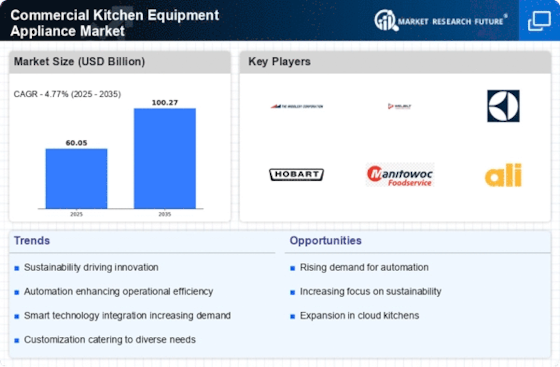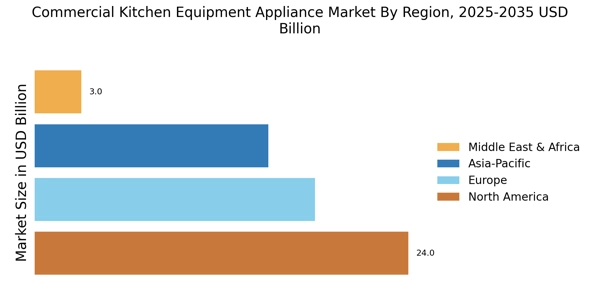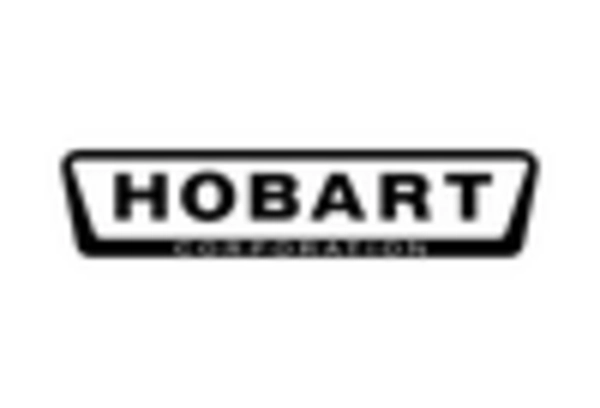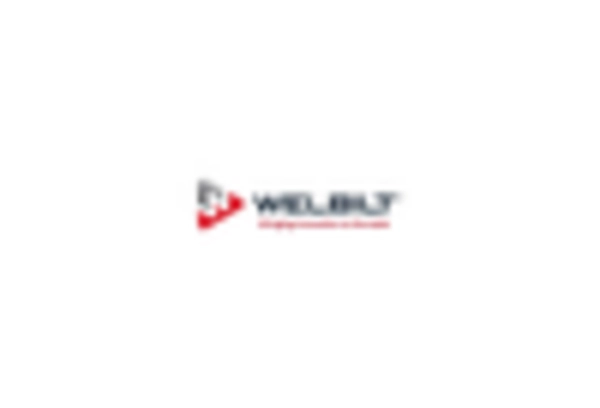Focus on Health and Nutrition
The growing emphasis on health and nutrition is influencing the Commercial Kitchen Equipment Appliance Market. As consumers become more health-conscious, food service providers are adapting their menus to include healthier options. This shift necessitates the use of specialized kitchen equipment that can prepare nutritious meals efficiently. For example, steamers and grills that preserve nutrients are becoming increasingly popular in commercial kitchens. Market Research Future indicates that the health food segment is expected to grow at a rate of 5% annually, prompting restaurants and catering services to invest in equipment that aligns with this trend. Consequently, the focus on health and nutrition is likely to drive demand for specific types of kitchen appliances, shaping the future of the market.
Growth of the Food Service Industry
The expansion of the food service industry serves as a significant catalyst for the Commercial Kitchen Equipment Appliance Market. With the proliferation of restaurants, cafes, and catering services, there is an escalating need for efficient and reliable kitchen appliances. Recent statistics indicate that the food service industry has been experiencing steady growth, with an estimated increase of 3.5% annually. This growth necessitates the adoption of modern kitchen equipment that can meet the demands of high-volume food production. As establishments strive to enhance operational efficiency and customer satisfaction, the investment in advanced kitchen appliances becomes imperative. This trend not only supports the growth of the food service sector but also propels the demand for innovative commercial kitchen equipment.
Rising Demand for Convenience Foods
The increasing consumer preference for convenience foods is a notable driver in the Commercial Kitchen Equipment Appliance Market. As lifestyles become busier, the demand for quick and easy meal solutions rises. This trend compels restaurants and food service providers to invest in advanced kitchen equipment that can efficiently prepare and serve convenience foods. According to recent data, the convenience food sector is projected to grow at a compound annual growth rate of approximately 4.5% over the next few years. Consequently, commercial kitchens are likely to require specialized appliances that can handle high volumes of food preparation while maintaining quality and taste. This shift towards convenience is expected to drive innovation and investment in commercial kitchen equipment, thereby enhancing the overall market landscape.
Regulatory Compliance and Food Safety Standards
The stringent regulatory compliance and food safety standards are pivotal drivers in the Commercial Kitchen Equipment Appliance Market. As governments and health organizations impose stricter regulations to ensure food safety, commercial kitchens must invest in equipment that meets these standards. This includes appliances that facilitate proper food storage, cooking, and sanitation. Recent data suggests that the food safety equipment market is projected to grow by approximately 6% annually, reflecting the increasing importance of compliance in the food service sector. As establishments strive to adhere to these regulations, the demand for reliable and certified kitchen equipment is expected to rise, thereby influencing purchasing decisions and market growth.
Technological Advancements in Kitchen Equipment
Technological advancements are reshaping the Commercial Kitchen Equipment Appliance Market, driving the adoption of innovative solutions. The integration of smart technologies, such as IoT-enabled appliances and automation, enhances operational efficiency and reduces labor costs. For instance, smart ovens and refrigerators can monitor food temperatures and inventory levels, ensuring optimal food safety and reducing waste. The market for smart kitchen appliances is projected to grow significantly, with estimates suggesting a potential increase of over 20% in the next five years. As commercial kitchens seek to streamline operations and improve productivity, the demand for technologically advanced equipment is likely to surge, thereby influencing market dynamics.


















Leave a Comment